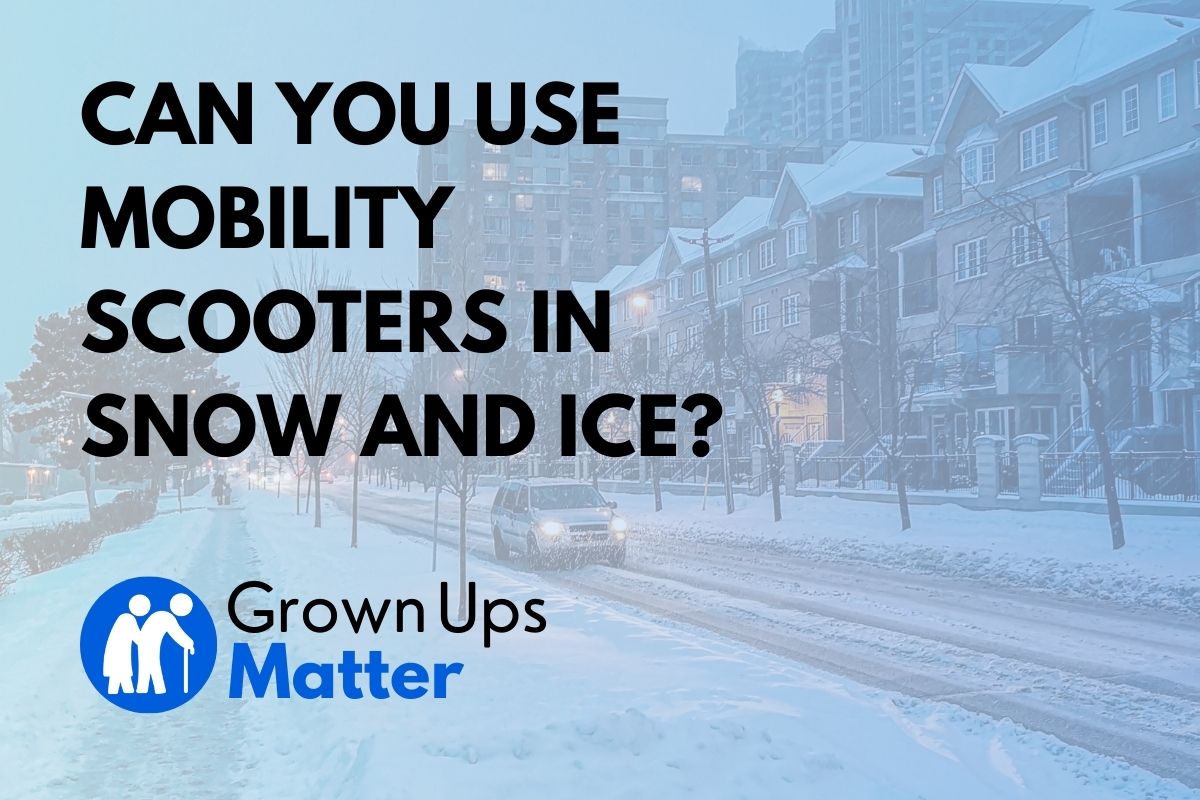As winter approaches, one question that often comes up for users of mobility scooters is whether they can brave the icy and snowy conditions on their trusted rides.
Mobility scooters have become an essential tool for many people, ensuring their independence and freedom to navigate their surroundings comfortably.
Yet, the prospect of slippery sidewalks and snow-covered paths can be daunting.
In this comprehensive guide, we aim to address your concerns and provide you with the information you need to make an informed decision.
Key Takeaways
- Using a mobility scooter in snow and ice is possible, but it requires special care and caution. While it’s not advisable to use your scooter in severe weather conditions, light snow and ice can be managed with a combination of good judgment, careful navigation, and the right scooter equipment.
- There’s a limit to how much snow a mobility scooter can handle. Most mobility scooters can manage about 1 to 2 inches of snow. Any more than that, and you risk getting your scooter stuck or damaging its electrical components.
- Not all mobility scooters are waterproof. It’s essential to check the IP rating (Ingress Protection) of your scooter to know the extent of its protection against water and dust. Driving your scooter in wet, snowy conditions when it’s not designed for it could cause lasting damage.
- Driving a mobility scooter in snow and ice comes with risks. These include the potential for slipping and falling, hypothermia, frostbite, and damage to your scooter. It’s crucial to consider these risks before deciding to venture out.
- Taking care of your scooter after a snowy trip is important. This includes drying it off thoroughly, cleaning the tires, and storing it in a dry, warm place to prevent damage to its components.
Can You Use Your Mobility Scooter in the Snow and Ice?
It’s a common myth that mobility scooters can’t be used in snow or ice. While it’s true that these conditions present challenges, it doesn’t mean your mobility scooter is grounded for the winter season.
Most mobility scooters are built to handle light snow and ice, especially if they are equipped with the right features, such as anti-tip wheels, good traction tires, and a strong motor. However, it’s important to remember that your safety is paramount. So, even though you can use your scooter in snow and ice, it’s crucial to do so with caution and common sense.
Also, make sure to understand the limitations of your specific mobility scooter model. You can find useful information on this in our types of mobility scooters article, which offers a comprehensive look at the different types and their unique features and capabilities.
Finally, consider whether you’re physically prepared to handle these conditions. Cold weather can make medical conditions worse and can affect your ability to safely operate your scooter. If you have any doubts, it’s always a good idea to consult with a healthcare professional.
How Much Snow is Too Much Snow for a Disability Scooter?
The amount of snow a mobility scooter can handle depends largely on its design and specifications. Most scooters can manage about 1 to 2 inches of snow without a problem.
However, once the snow depth exceeds this, it can start to pose significant challenges. Too much snow can get stuck in the scooter’s wheels, making it harder to maneuver. Moreover, the snow can reach the scooter’s undercarriage, where it could damage the motor and electrical components.
Before deciding to venture out, it’s a good idea to check your local weather forecast and snowfall levels. Also, ensure you understand your mobility scooter’s capabilities. Our mobility scooter buying guide can be a great resource for understanding the technical aspects of different scooter models.
Are Mobility Scooters Waterproof?
It’s crucial to keep in mind that not all mobility scooters are waterproof. Some are only water-resistant or splash-proof, while others might not have any water protection at all.
Before taking your scooter out in the snow, it’s important to understand its water protection level. This is typically indicated by an IP rating. A higher IP rating signifies better protection against water and dust. For instance, an IP65-rated scooter can handle low-pressure water jets from any direction, while an IPX0 scooter has no water protection.
It’s important to remember that even if your scooter is waterproof, prolonged exposure to moisture can still cause corrosion or damage over time. This is particularly true if the scooter is not properly cared for after use in wet conditions.
For more information on this, you can refer to our article Are mobility scooters waterproof?, which provides a thorough exploration of this subject.
Risks of Driving Your Mobility Scooter in the Snow and Ice
Driving a mobility scooter on ice or snow isn’t just a question of whether it’s possible or not, but also whether it’s safe. Ice and snow present a series of risks to mobility scooter users that must be seriously considered.
Decreased Traction is a significant issue when driving in snow or on icy surfaces. Mobility scooters may slip and lose their grip on the road. This can lead to the scooter tipping over, or you losing control of your scooter. Both outcomes are potentially dangerous, especially if you’re traveling at higher speeds.
Furthermore, snow and ice can impair the scooter’s mechanical components. Ice can accumulate on the scooter’s undercarriage, while moisture can seep into electrical parts, causing damage over time. This can lead to costly repairs, as detailed in our article on mobility scooter repair alternatives.
Lastly, in colder weather, battery performance may decrease, leading to a shorter travel distance. This can be a serious issue if your battery runs out far from home. Check our mobility scooter battery care guide for tips on maintaining battery health in cold weather.
Taking Care of Your Scooter After a Snowy Trip
Taking care of your mobility scooter after a ride in the snow or ice is crucial to maintain its optimal performance and longevity.
Once you’re back indoors, clear any snow or ice from your scooter as soon as possible to prevent it from melting and causing water damage.
Next, dry off the scooter completely, especially around the battery compartment and electrical components. Moisture can cause rust and damage electrical systems over time, as explained in our mobility scooter maintenance guide.
Lastly, store the scooter in a warm, dry place to prevent any residual moisture from freezing overnight, which could cause damage.
Snow Tires for Mobility Scooters
Snow tires, also known as winter tires, can improve your mobility scooter’s performance in snowy or icy conditions. These tires have a specially designed tread that provides increased traction on slippery surfaces.
When considering snow tires for your mobility scooter, it’s crucial to select a size that fits your specific scooter model. Make sure to consult the mobility scooter buying guide to learn more about choosing the right accessories for your scooter.
Snow Chains as an Alternative
If snow tires are not available or if you’re looking for a more budget-friendly option, snow chains can be a viable alternative. They are fitted over your scooter’s existing tires to provide additional grip on slippery surfaces.
While snow chains can significantly improve traction, they can also make the ride more bumpy. You should take this into account, especially if you have back or spine issues.
Mobility Scooter Covers
A cover can protect your mobility scooter from the elements, including snow, ice, and even sunlight. When selecting a cover, look for one that is waterproof and durable.
Having a cover is especially beneficial if you must leave your scooter outdoors during winter. Check out this article on mobility scooter mistakes for more tips on scooter maintenance and protection.
Best Mobility Scooters for the Snow
If you frequently need to navigate in snowy or icy conditions, it may be worth investing in a mobility scooter designed for these conditions.
Some scooters feature larger tires, increased ground clearance, and enhanced power to navigate tricky terrains.
You can check out our articles on the best all-terrain mobility scooters and best heavy-duty mobility scooters for more specific recommendations.
Remember, the best scooter for you is the one that best fits your individual needs.
This includes comfort, budget, and the types of environments you’ll typically be traveling in.
Be sure to consider all these factors when making your decision.
All the claims made in this article are only for informational purposes, based on the writer’s experience and not clinical advice. You should always consult your physician or physical therapist if you have any doubts about how this applies to your specific case.

Rami is an economist with a passion for personal finance and a desire to help people make the most of their retirement years. He’s also the tech mind that made all of this possible, and a marketing enthusiast. In his articles, Ramiro offers real-life advice and resources for seniors looking to manage their finances and make the most of their retirement savings. He is dedicated to helping his readers live comfortably and securely during their golden years.

